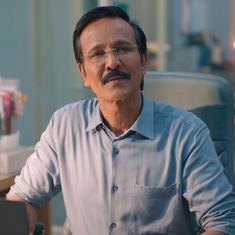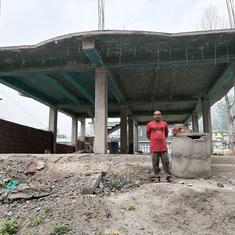How does one make sense of Dera Sacha Sauda and its controversial chief, Gurmeet Ram Rahim Singh Insan? In 2013, an opportunity to attend a congregation near the Japanese Park in Rohini, Delhi, which was addressed by the chief of the DSS, was very insightful.
A large open ground had been converted into a huge venue, which was overflowing with people. An army of premis and uniformed sevadaars worked with great fervour to manage the crowd. The venue was under heavy security surveillance, from the entry gate to the inner area from where the dera chief was to deliver his sermon. The chief’s personal and official bodyguards had formed a ring cordoning off the crowd. The entire area was also being monitored through CCTV. At the entry gate, each person was thoroughly frisked and checked. A large number of followers were wearing metal lockets bearing the insignia of the dera, which stated, “God is one”, and many of them had pictures of Gurmeet Ram Rahim Singh.
People – young and old, men and women – had gathered from not just Delhi and the neighbouring Haryana, but also from Punjab, Himachal, Madhya Pradesh and Rajasthan. Outside the venue were shops selling lockets, calendars, posters, herbal medicines, energy tonic, toys, albums containing photos of Gurmeet Ram Rahim Singh and CDs of his songs and videos. The common theme across all these products was the ubiquitous and exclusive presence of the dera chief. Each product carried the stamp of the dera. Nothing even remotely related to Dalit icons or history was visible. It was all about Pitaji.
There were a few images of Satnam Singh, but there was hardly anything on the founder of DSS, Beparwah Mastana Baluchistani. It appeared to be an effort to erase the not-so-dazzling past before Gurmeet Singh became Ram Rahim. The colourful guru, or Pitaji, in all his superhuman avatars was resplendent in every corner of the venue and on every product, leaving his followers spellbound and visibly starstruck. Gurmeet Singh, dressed in his trademark shiny, bright T-shirts, hat and dark glasses, was featured on posters and calendars, depicted playing golf, driving SUVs or as a fighter. The striking imagery celebrated the alpha male image of Pitaji and depicted him as a saviour and protector.
Thousands braved the summer heat, and muscular sevadaars, men and women, tried to bring some respite by fanning themselves as they sat under the tents. Men and women were segregated.
What was unique about Pitaji’s discourse was that it was a purely moral lecture, without any grand theorising or references to philosophy or religious texts. The content revolved around how to live happily with one’s family, the importance of respecting one’s elders, and following healthy eating and living practices. There was no sharing of esoteric philosophical concepts dealing with questions of life and death. Gurmeet Ram Rahim Singh spoke with empathy and in a language that connected with his people, most of whom were from the underclass.
I was sitting next to a father-and-son duo. The deep attention, devotion and discipline with which they listened to the guru were remarkable and interesting. The followers were ordinary in many senses; they had all come seeking relief from health issues, childlessness and general misfortune. There was no mention of caste. No Ambedkar. No Kanshi Ram. There was nothing much on religion either.
But the bottled energy tonics and tins of protein powder with photographs of bodybuilders on their labels were in perfect consonance with the dera’s profile, reflecting the chief’s uncanny eye for cultural nuances and what works where. The dera understood Haryana’s fascination for power sports like wrestling, and hence these products were prominently displayed.
Dera Sacha Sauda, in this sense, is a non-Dalit dera. It is an individual enterprise – an establishment of, for and by Gurmeet Ram Rahim Singh. Yet it draws on the vast reservoir of disgruntled, free-floating individuals, overwhelmingly Dalits, who are alienated from the mainstream religious anchors in the region.
The appellations of Ram, Rahim and Insan that Gurmeet Singh has gradually added to his name point to an entrepreneurial orientation and a smart reading of the region’s syncretic history. He has used these to woo this free-floating population with his flashy, jazzy ways and the creation of a space that promises his followers all the services they could ever need.
In 2016, Gurmeet Singh was conferred with an honorary doctorate by a London-based university in recognition of his record-breaking programmes in the field of social welfare like blood donation and drug de-addiction. Now “Dr” too was appended to his name, making him Dr Gurmeet Ram Rahim Singh Insan. His name was like an identity menu designed to appeal to a region that celebrated multiple and pluralistic identities.
The interesting part is that, notwithstanding his conviction in multiple cases and his imprisonment, there is no lack of zing in either the DSS or the guru’s life. Rather, the dera is much more in the public eye, and its publicity networks remain as vibrant and dynamic as ever, with the guru releasing a series of videos on YouTube. During his repeated furloughs, he mostly stays in the dera campus at Barnawa, in Baghpat, Uttar Pradesh.
During the forty-day parole that was granted on 14 October 2022, he released three music videos titled “Sadi nit Diwali” (Every day is Diwali), “Jaago duniya de loko” (Awake, people of the world) and “Chat pe chat” (referring to mobile chatting). All three tracks were written, produced, sung and composed by him.
The Chandigarh edition of the Indian Express and other newspapers of 11 April 2022 was full of DSS-sponsored advertorials featuring pictures of Gurmeet Ram Rahim and the sangat. These advertorials were presented as news items. Followers of the dera celebrate April as the founding month of the Dera Sacha Sauda, as it was established by Shah Mastana Baluchistani on 28 April 1948. To commemorate and celebrate the occasion, naam-charchas (events involving the recitation of “sacred words”) are organised across Punjab, Himachal, Haryana and Uttar Pradesh. These events are publicised through sponsored advertorials to build the DSS brand.
The advertorials from April 2022, all similar in style and content, reported on such events from various places like Jind, Paonta Sahib, Bathinda and other centres. They highlighted three things: the guru’s name – Dr Sant Gurmeet Ram Rahim Singh Insan – in bold type; the charitable works carried out by the dera, such as donating tricycles to the disabled, handing the keys of newly constructed houses to the homeless and distributing ration kits to hundreds of poor and destitute; and the dera’s numerical strength of six crore followers. The campaign was unmistakably well thought out. Interestingly, that many advertorials also mentioned the date of the “Jam-e-Insan”, which was held in April 2007 and became controversial when Gurmeet Singh was accused of impersonating Guru Gobind Singh.
The strength of the DSS lies in its extensive networks of fellowship across regions, which keep the system afloat and working despite the dera being dogged by controversies. One gets the impression that this network comprises groups of trusted, long-time dera members who work as foot soldiers in the villages and towns. A central command keeps this web of networks well-oiled with funds and other amenities While at another time the organisation and its networks may have collapsed with the chief’s conviction for such heinous crimes as rape and murder, clearly this is a different time. Charisma indeed lies in the eyes of the beholder and is eternal – more so now, when there is no routinization as social media and technological tools are used to constantly reinvent the chief’s mystique and make his halo shine brighter. Gurmeet Ram Rahim Singh continues to command the respect and hero-worship of his followers. His entrepreneurial acumen, coupled with his extraordinary ability to sense the direction of the political winds, has been on full display following his conviction and imprisonment.

Excerpted with permission from The Deras: Culture, Diversity and Politics, Santosh K Singh, Penguin India.










